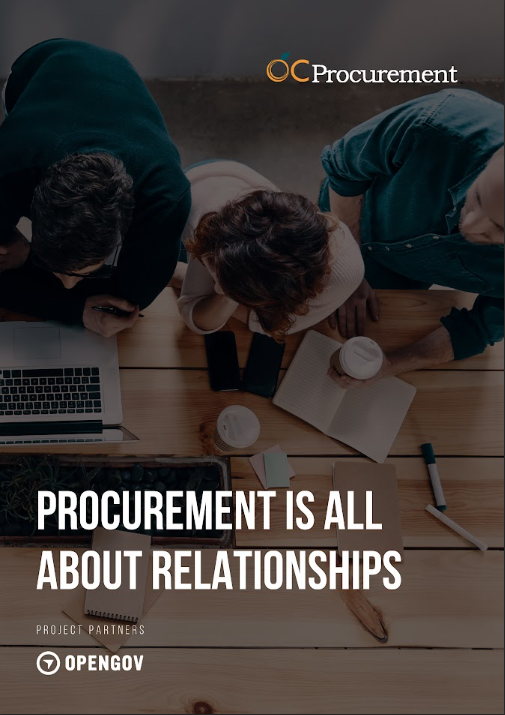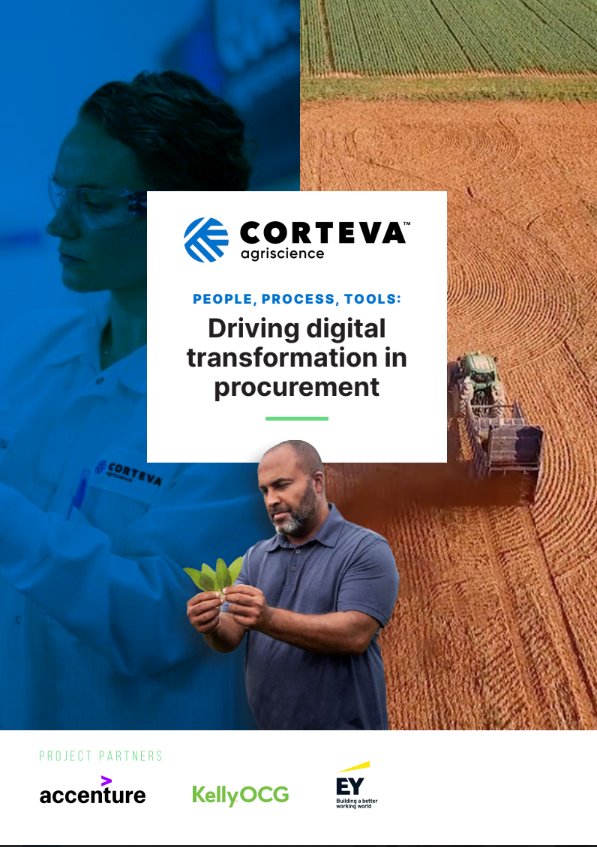In the procurement conversation, the current discourse is often dominated by the latest technologies that continue to digitise the procurement process, or in the current landscape, how procurement has responded to the COVID19 pandemic. Sustainability inadvertently takes a backseat given these extraordinary times.
For a company like Schneider Electric who is a leading provider of energy and automation digital solutions, sustainability has always been a core focus for the company, and procurement is one of the key levers that Schneider uses to achieve its sustainability commitments. Though sustainability isn’t a common consideration when transforming procurement, it is a key driving force for Dan Bartel, Chief Procurement Officer of Schneider Electric, as he leads the function on its journey.

Dan Bartel, CPO, Schneider Electric
“The best sportsmen know how to position themselves where the ball will be, not where it was,” said Dan, “likewise, our vision for procurement is to partner with top quality and innovative suppliers to produce competitive solutions for Schneider. We think that’s essential for the company to be successful with its strategy and take it to where it wants to be.”
The procurement transformation of Schneider consists of three pillars:
The first pillar focuses on enabling growth through supplier partnerships in order to bring in technologies to improve Schneider’s market offering.
The second pillar falls in line with the traditional perspective as to what procurement does for a business; driving bottom line results. “It’s absolutely at the core of what we do in procurement in Schneider,” says Bartel. “Our fundamentals need to be stronger than ever as we tackle challenges in a post-Covid world where supply chains are expected to be shorter, more local and have greater resiliency.”
The third pillar is sustainability and helping Schneider advance towards its sustainability goals. This is accomplished by partnering with suppliers to achieve corporate social responsibility as well as product and material compliance targets. “Simplicity helps with sustainability”, Bartel added. “There’s a massive effort on complexity reduction throughout Schneider. Not just on our organisation design, but also our product offering because having too many products adds unnecessary complexity and noise to the system.”
Bartel, whose career has been heavily industry focused, as opposed to the more common CPO journey that spans multiple industries, has held several CPO roles throughout his career. Having joined Schneider from ABB in 2019, Bartel reflects on how the procurement conversation has changed dramatically over the course of his career. “I find myself very fortunate,” he notes. “I came into procurement when it was deemed less strategic and have seen the function evolve over the last 25 years. Today, a company that overlooks procurement does so at its own peril.”
Procurement plays a strategic role in Schneider’s success and future growth. But as organisations the world over ‘wake up’ to the strategic role of procurement, has Schneider always been ahead of the curve? “In Schneider, the external spend that we manage is equal to half of the revenue. A previous mentor of mine would take the targeted cost reduction and divide it by the operating margin of the company and say, ‘That’s the equal value of procurement in our company in terms of sales,’” says Bartel. “That was really powerful and it helped people understand the relevance of the function. I think it’s come a long way but we’re not done. There’s still more we can do.”
Over the course of the next three years, Bartel and the procurement teams will roll out several changes that are closely aligned with the global supply chain strategy of Schneider. “We’ve defined where we want to be three years from now and worked our way backwards towards the key milestones we need to achieve annually in order to get there,” he says. “Review, refresh, repeat! The process has to be dynamic and we keep it flexible to evaluate and respond to changes, like Covid.”
Given Schneider’s large global footprint, Bartel is keen to stress that he and his team form part of a broader global supply chain organisation that enables him to achieve things at speed as opposed to the traditional and rigid decentralised supply chain approach of many other companies in similar positions.
“It enables us to get the investment allocations that we need to really reach our full potential, but of course we still have to deliver a believable business case and we have to have the trust of the organisation to go deploy that”
Normally as part of a transformation story, we hear of the CPO coming in and having to gain operational buy in from leadership. This is often challenge number one. For Bartel, he admits to being “incredibly blessed” to be a part of a company in which procurement is recognized for the true strategic arm of the business that it is. That being said, he understands that results still speak volumes. “It’s really empowering, not just to me but to everyone in the organisation,” he says. “It enables us to get the investment allocations that we need to really reach our full potential, but of course we still have to deliver a robust business case and earn the continued trust of the organisation with results. The door is open and the executive leadership expect us to come with those proposals. It’s much more rewarding to spend time thinking ahead and building resiliency for the future than working to justify the need for the function.”
So just how will this transformation improve on Schneider’s current market proposition? Bartel has outlined the means in which procurement will look to bring in more competitive solutions through a realigned approach to supplier relationships. But what will be the real tangible benefit from that? “That’s a good question,” he muses. “You wouldn’t want electricity to quit on you when you’re in the midst of a medical procedure, nor would you want the power to fail suddenly if you’re running a data center. From a customer perspective, our products support life critical infrastructure and our quality and reliability must be second to none. From a company perspective, we should demonstrate tangible and improved financial performance as a result of the work that we do, and we should have achieved our sustainability targets.”
When Bartel entered the business, the strategy for procurement had already been laid out and defined. This is what he described as a ‘luxurious’ thing for any new CPO. Over the past year, Bartel and his team have been delivering against this strategy and fine tuning where needed. One such part of this is improving the way in which Schneider looks at the market and how it influences the business offering. “You don’t want to build a functional strategy just based on industry trends and what everybody else is doing. Like I said earlier, we need to be where the ball will be. Post-Covid, we clearly see the need to have more “just-in-case” supply chains with redundancy and resilience factored in. We need to build in climate considerations as part of our competitive strategy. No one has a crystal ball on what the future holds, therefore to understand better the leading trends in Procurement we have amped up our efforts to exchange our learnings externally with other companies like Procurement Leaders and the Hackett Group and learn from our peers across industries.”
“We weren’t focused simply on what we could do differently to get better results, but how we could better partner together to create value?”
Another key change on which Bartel has focused (even before Covid) has been a robust multi-sourcing strategy, which wasn’t part of the overall functional strategy previously. Where once there were spot assessments, Schneider now looks more closely at how it can increase the resiliency of its supplier network. The supplier relationship model is a crucial element for any procurement function and Schneider has looked extremely closely at how it can strengthen ties with key suppliers. To achieve this, the company held a global strategic supplier day in which it invited 100 strategic suppliers from all over the world. “We spent a day and a half together with all of these suppliers. Half of our executive committee was participating directly, including our CEO, our CFO and our Chief Supply Chain Officer, engaging together with our suppliers,” says Bartel. “We weren’t focused simply on what we could do differently to get better results, but how we can better partner together to create value and win together.”
For Bartel, this supplier event was all about broadening the mindset of the category managers and senior leaders to think outside their own business mindsets to foster innovative ideas and overall greater relationships with those suppliers. “It’s about taking those partnerships forward in a meaningful way and how this is also key for Schneider as a business going forward,” he says. “We intend to become less transactional and to invest more in supplier relationships in order to create something together. It’s a real one-plus-one-equals-three principle that our competitors aren’t doing to the same level. We want to create an advantage that stems from market growth, enhanced financial performance or improved sustainability. Those are the three things that we are working with strategic suppliers on.”
Fundamentally, it’s about people and relationships. “It’s a journey and not everyone sees the destination. On one hand, expectations need to be well understood and mutually aligned from the very beginning. This creates pressure, should you not meet those expectations at times,” he says. “It’s about making sure that the people have the support around them to do the job beyond the support provided directly by me. I take a lot of pride and put a lot of energy into making sure our people are successful and so we have a matrix manager in some places who provides a similar type of support in the onboarding of our people into the procurement role, who clarifies the expectations and really enables our people to be successful.”
Training and upskilling is also key to this and Schneider works closely with Drozak Consulting on this front. Bartel asked Drozak to come in and shake up his organisation, but recognizes it goes well beyond that. “They bring a process, very good training, advice as well as coaching and mentoring of the teams to better prepare them to engage in discussions with suppliers,” he says. “In parts of our business, there was a need to shake things up. Drozak brought a process, a standardized way of working as well as training and key support. They’ve done an exemplary job in helping us to enable and empower our people to really drive more value from those supplier relationships.”
Practicing what he preaches, Bartel describes how Drozak and Schneider have to continue to innovate in their own relationship as well. “You can’t be a one trick pony for a long term successful collaboration. Drozak has innovated with us along the way. For example, during Covid, we couldn’t do site visits anymore so Drozak assisted us with some very creative ways to make that process entirely virtual and it works.”
“The longer you work together with a company like Drozak who innovates along with you, the better you get to know each other’s strengths and weaknesses,” says Bartel. “It then becomes so much easier to find things that you can continue to do, that you should continue to do together.”
At the time of writing the world has been gripped by the COVID19 pandemic, which has seen major disruption to a number of global businesses, alongside the significant toll on human life. Schneider has not been invulnerable to this, and Bartel admits that the company has seen both setbacks as well as opportunities to grow.
There have been things we had to accelerate and some things we had to slow down but in the long term, the strategy remains but with a couple of additional elements,” he says. “It has really shined a bright light on the single source situations that we have in the business and it’s given us an opportunity to take action and make the investments that we need to make in order to build a more resilient supply chain for the future.”
The financial strain caused by the pandemic has also forced a rethink on project priorities, as Bartel notes. “We’re making big investments in digital and some of those were slowed down a little bit but there’s other aspects of digital, like how we interact with our suppliers that we are bringing forward. As an example, we have source-to-contract tool deployment that we accelerated substantially because it helped us through the crisis.”
“…it’s given us an opportunity to take action and make the investments that we need to make in order to build a more resilient supply chain for the future”
Despite this sudden and difficult obstacle in the road, the future is bright for procurement at Schneider. Thanks to a commitment to redefining procurement, supported by a truly collaborative culture and a drive for innovation and sustainability in line with the broader business strategy, Schneider is well placed to succeed on this journey of procurement transformation. Bartel sums up by reflecting on what has made the journey successful so far and what needs to be done for continued success.
“It’s about developing relationships with all key players, really defining the problem and working with the team to come up with something new that you want to accomplish together,” he says. “The biggest opportunity lies in the fact that no one knows what the future holds. Covid has been the catalyst for major shifts in how we work, play and interact with each other. Those who can embrace the changes and move quickly will set themselves for success. For me, one thing’s for sure and that is that Procurement is the place to be.”









